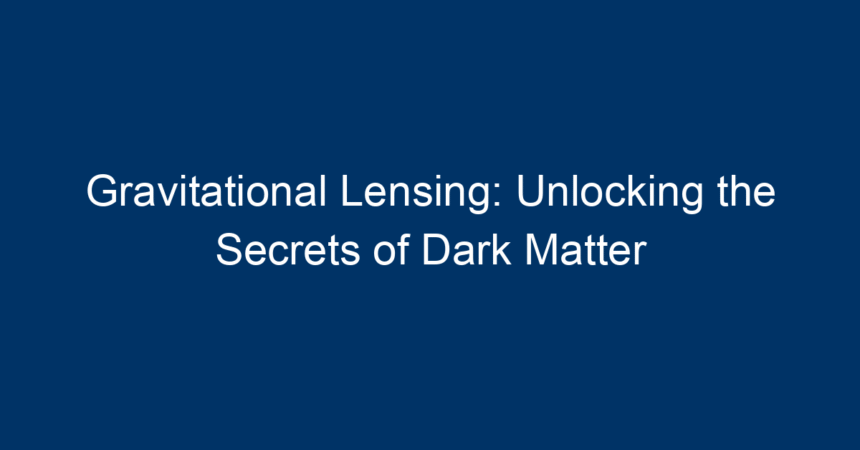Introduction: The Cosmic Mystery
The universe is filled with mysteries, but perhaps none are more tantalizing than dark matter. While it makes up about 27% of the universe, its presence remains elusive, detectable only through indirect means. One of these methods is gravitational lensing, a powerful tool that astronomers employ to understand both dark matter and the cosmos at large. In this article, we will delve into the phenomenon of gravitational lensing, how it helps us unlock the secrets of dark matter, and what the future might hold for this fascinating field of study.
What is Gravitational Lensing?
Gravitational lensing occurs when a massive object, such as a galaxy or galaxy cluster, lies between a distant light source and an observer. The massive object creates a gravitational field that bends the light coming from the distant source, much like how a glass lens focuses light. This effect not only magnifies the distant light but can also create multiple images of that light source.
The Types of Gravitational Lensing
Gravitational lensing can be categorized into three main types:
-
Strong Lensing: This occurs when the gravitational field is strong enough to create multiple images of the same astronomical object or form arcs and rings of light known as Einstein rings. Strong lensing provides high-resolution data and allows scientists to map the distribution of dark matter in the lensing object.
-
Weak Lensing: Unlike strong lensing, weak lensing produces subtle distortions in the shapes of background galaxies. These distortions can be statistically analyzed to infer the presence of dark matter without needing to resolve individual images.
- Microlensing: This type involves smaller masses, such as stars or planets, that lead to temporary increases in brightness of a background star. Microlensing studies have been instrumental in discovering exoplanets and studying dark matter’s properties.
The Connection Between Gravitational Lensing and Dark Matter
Mapping Dark Matter
Dark matter does not emit, absorb, or reflect light, making it difficult to study using traditional astronomical techniques. However, gravitational lensing provides a unique way to map its presence. By analyzing the distortions of background light sources caused by foreground massive objects, astronomers can create detailed maps of dark matter’s distribution.
For instance, when scientists observe how light from distant galaxies is warped by a galaxy cluster, the extent of that warping reveals the amount of mass present in the galaxy cluster. Since the visible matter is far less than the inferred mass, it strongly suggests the existence of dark matter.
Insights from the Cosmic Microwave Background
Another fascinating area where gravitational lensing plays a role is the Cosmic Microwave Background (CMB). The CMB is the afterglow of the Big Bang, and its slight temperature fluctuations carry valuable information about the early universe. Gravitational lensing of the CMB allows scientists to study the distribution of dark matter across cosmic time.
Observing how the CMB is lensed by dark matter lets researchers map structures in the universe and understand dark matter’s role in the formation of galaxies.
Recent Discoveries in Gravitational Lensing
The Hubble Space Telescope’s Contributions
The Hubble Space Telescope (HST) has played a pivotal role in advancing our understanding of gravitational lensing. Its high-resolution images have allowed astronomers to conduct detailed studies of galaxy clusters, leading to significant discoveries about dark matter.
For instance, HST observations have uncovered intricate structures in gravitational lensing that hint at the complexity of dark matter distribution, revealing that it is not uniformly scattered but clumped in various regions.
Ground-Based Observatories
While Hubble has provided invaluable insights, ground-based observatories like the Atacama Large Millimeter Array (ALMA) and the Magellan Telescopes have also made crucial contributions to gravitational lensing studies. These facilities utilize advanced technologies to observe weak lensing across large swaths of the sky, further enhancing our understanding of the universe’s structure and the role of dark matter.
Challenges and Limitations of Gravitational Lensing
Observational Challenges
Despite its strengths, gravitational lensing comes with challenges. The complexity of cosmic structures can lead to uncertainties in the mass distributions derived from lensing studies. Moreover, separating the effects of regular matter from those of dark matter can be mathematically intricate.
The Nature of Dark Matter
Another significant limitation lies in the very nature of dark matter itself. We do not fully understand what dark matter is composed of, and differing models of dark matter lead to varied predictions regarding gravitational lensing effects. This lack of consensus complicates efforts to directly relate gravitational lensing observations to dark matter properties.
Future Prospects and Technological Advancements
The James Webb Space Telescope
With the launch of the James Webb Space Telescope (JWST), the future of gravitational lensing studies looks promising. JWST’s enhanced capabilities will allow for deeper observations of distant galaxies and improved measurements of lensing effects, leading to better understanding of dark matter and cosmic evolution.
Large-Scale Sky Surveys
Upcoming large-scale sky surveys, such as the European Space Agency’s Euclid mission and the Vera C. Rubin Observatory’s Legacy Survey of Space and Time (LSST), are expected to revolutionize our knowledge of dark matter. By collecting vast amounts of data on gravitational lensing events, these projects will provide unprecedented insights into the distribution of dark matter across the universe.
Conclusion: What Lies Ahead?
Gravitational lensing stands at the forefront of the quest to unravel the mysteries of dark matter. The ability to observe and map dark matter through lensing effects provides a unique window into the cosmos, revealing structures and relationships that were previously hidden.
Actionable Insights:
- Stay Informed: Keep an eye on upcoming missions like JWST and Euclid, as their findings could reshape our understanding of dark matter.
- Engage in Community Discussions: Join scientific communities or online forums centered around astronomy and astrophysics to discuss the latest breakthroughs in gravitational lensing.
- Support Dark Matter Research: Advocate for funding and support for astrophysical research focusing on dark matter studies.
As we continue to explore the universe, gravitational lensing will remain an invaluable tool in our repertoire, shedding light on the most profound mysteries of our existence.
By embracing this phenomenon, we not only unlock the secrets of dark matter but also uncover the rich tapestry of the universe itself.




